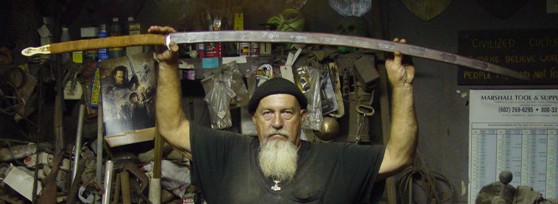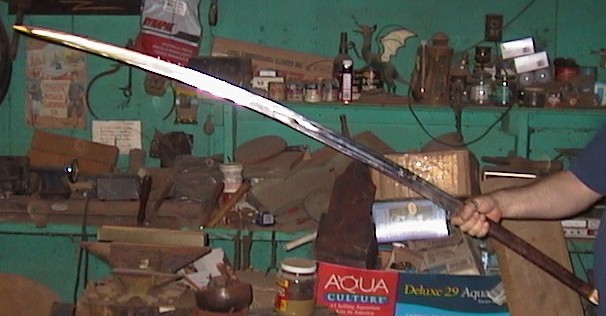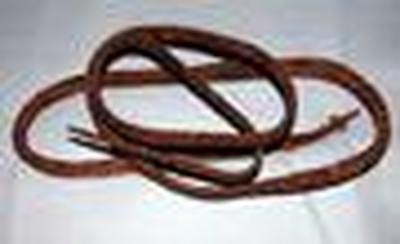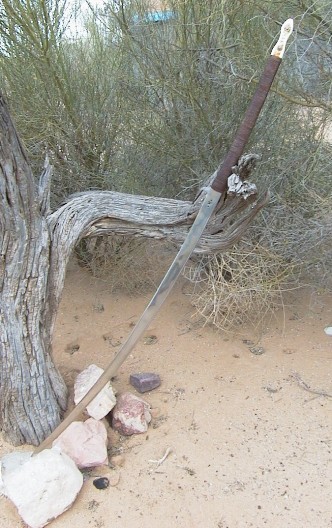| Author |
Message |
Laurie W
Industry Professional

|
 Posted: Mon 23 Jan, 2006 11:55 pm Post subject: Rhomphia Posted: Mon 23 Jan, 2006 11:55 pm Post subject: Rhomphia |
 |
|
The attachment shows a Kirby holding a Rhomphia made nearly two years ago. This belongs to the same person who owns both the Kopis and Macheria shown on our website. The second one shows the owner holding it but I really wish the photo came out better to show the engraving on the blade (similar to the Macheria).
This was handforged from one piece of Spring Steel and the dimensions were based on an actual one shown in the other attachments. The blade tempered using his traditional methods. The total length was 65 inches and weighed approximately 3 pounds (but not over). The shank is 20 inches and slightly rounded for better holding. The owner wrapped it with flat leather cord. The 4 inch, 2 piece bone "grip" is riveted like the original. Apparently some records say the grip material was wood, bone or horn. So it was decided bone would make a good contrast. The blade is slightly curved inward but not enough to prevent it from being used in a thrusting manner and the owner honed the inside edge quite sharp. Although some records say the Thracians carried this on or over their shoulders (a few finds show a hole near or on the "finger guard" for a carrying thong), the scabbard makes far more common sense for carrying purposes and storage.....especially knowing how sharp it is. Modern cars not withstanding. It is made so he can carry it across his back.
The flat leather wrapping, it was felt would have gave the Rhomphia better handling and less slippage from blood, water or even heat. Or anything else that would cause the hands not to have a good grip. Kirby and the customer talked about this at great length as to whether or not this would have been done. All the finds show nothing, but then any such material could have been destroyed during the ritual "killing" and burning as the original was (was just a twisted,tangled "ball" carefully straightened out) The customer is a huge Macedonian/Thracian collector with a sizeable library and also makes some of his own gear for living history purposes. A friend of his is a Great Sword devotee and showed just how awesome this weapon would have been in a Thracian warrior's hands. Extremely quick and well balanced.
Some of you may recognize the actual pics from the one Mr. Piscopo had on a website. I wrote to him with some questions about this piece and Kirby's intentions of making one. Mr. Piscopo had offered to send this one for us to look at but I had to decline his gracious offer. I had hoped to send him photos after it was finally done, but learned he died. I think he would have liked to have seen this as he mentioned in another forum no one was making a Rhomphia and would have liked to see one made. Well, at least some of you will see it now. His photos were good enough for Kirby to work from and the customer did have some resource material showing others with text to help flesh out some details. The rest was up to Kirby's expertise and "eye".
As said, I just wish the unscabbarded photo was better and will try to get a better one as soon as I can. Enjoy.
 Attachment: 34.99 KB Attachment: 34.99 KB

Kirby holding scabbarded Rhomphia
 Attachment: 54.04 KB Attachment: 54.04 KB

Unscabbarded
 Attachment: 4.93 KB Attachment: 4.93 KB

Rounded shank, finger guard "stop" and grip
 Attachment: 8.1 KB Attachment: 8.1 KB
Original [ Download ]
Laurie Wise-Fraser FSA Scot.
Kirby Wise-Fraser FSA Scot.& Son
Arms and Armour
Last edited by Laurie W on Tue 24 Jan, 2006 1:52 pm; edited 3 times in total
|
|
   |
 |
Laurie W
Industry Professional

|
 Posted: Tue 24 Jan, 2006 12:09 am Post subject: Posted: Tue 24 Jan, 2006 12:09 am Post subject: |
 |
|
Photos of the original Rhomphia as "found" and closeup of "Finger Stop"/guard
 Attachment: 10.92 KB Attachment: 10.92 KB

 Attachment: 7.84 KB Attachment: 7.84 KB

|
|
   |
 |
Mikko Kuusirati

|
 Posted: Tue 24 Jan, 2006 1:25 pm Post subject: Posted: Tue 24 Jan, 2006 1:25 pm Post subject: |
 |
|
Whoah. I never actually realized just how BIG these things were... very impressive, not to mention beautiful.
"And sin, young man, is when you treat people like things. Including yourself. That's what sin is."
— Terry Pratchett, Carpe Jugulum
|
|
  |
 |
|
Wolfgang Armbruster
|
 Posted: Tue 24 Jan, 2006 1:48 pm Post subject: Posted: Tue 24 Jan, 2006 1:48 pm Post subject: |
 |
|
As I understand it the Rhomphia (thracian?) and the Falx (dacian?) are actually the same weapon. Is that correct?
If not, what are the differences? I'm a bit confused right now.
Btw: Awesome piece 
|
|
  |
 |
Laurie W
Industry Professional

|
 Posted: Tue 24 Jan, 2006 3:12 pm Post subject: Posted: Tue 24 Jan, 2006 3:12 pm Post subject: |
 |
|
The Dacian Falx was alittle shorter but that might depend. The examples of the Rhomphaia we saw also varied. However, most were longer than their Dacian cousin and none showing they had anything other than that short covered "grip". The Dacian blade was more curved inward "sickle" like and not as long. The grip/shank was usually wood covered. Most people do get the two confused.
Here is a Dacian reenactor using a falx from the XX Legion website back in 2001. The reenactor made his.
Falx from a Roman stele.
A site about the Thracians and the Rhomphaia (Rhomphia) with archeaological evidence. Good stuff here and you see what I mean.
-------
update
The Dacian reenactor is Steven Peffley of Albion Armourers Go to the "Reconstructions" to see his version and some prototypes. His Falx has a 2 piece wooden grip and his "Rhomphaia" (with finger hole) shows a two piece narrow wooden strips as "grip" covering.
But the one Kirby was replicating did not have any rivet holes other than in the short grip area. But it would make sense that some kind of shank covering would have been used....especially on a hot day!
|
|
   |
 |
|
Tim Lison
|
 Posted: Tue 24 Jan, 2006 3:52 pm Post subject: Posted: Tue 24 Jan, 2006 3:52 pm Post subject: |
 |
|
|
Very cool! Another nice piece from Kirby!
|
|
  |
 |
|
Wolfgang Armbruster
|
 Posted: Wed 25 Jan, 2006 2:33 am Post subject: Posted: Wed 25 Jan, 2006 2:33 am Post subject: |
 |
|
Thank you for the explanations! 
However, have doubts about the durability of these weapons. If we believe Plutarch and the other historians quoted on that site, then the Falx and Rhomphia wre both made of iron. Wrought iron bends rather easily and tends to stay bent. Was it possible to forge such a large weapon with that kind of metal? Or did they already have ways to increase the durability by patternwelding like the Celts (composite core, steely iron edges) ?
I wonder if someone already made an attempt to examine these weapons further and to make an metallurgical analysis.
|
|
  |
 |
|
Shane Allee
Industry Professional
|
 Posted: Wed 25 Jan, 2006 6:45 am Post subject: Posted: Wed 25 Jan, 2006 6:45 am Post subject: |
 |
|
There isn't exactly tons of research out there about the rhomphaia, and I can't say that I know of any which looks at the metallurgy side of things. If you think about it though, it would have taken a lot of iron to make one of these, so more than likely they wouldn't have been wasting their iron one something that wasn't an effective weapon. Anyone interested in these should take a look at the line drawings on the site and all at full size, they have been scaled down on that website. At the full size it is more clear how prominent that "T" back design really is on these things. Most of the time the handles are and "I" beam construction as well. So these things are designed to resist bending.
Shane
|
|
    |
 |
|
Wolfgang Armbruster
|
 Posted: Wed 25 Jan, 2006 8:24 am Post subject: Posted: Wed 25 Jan, 2006 8:24 am Post subject: |
 |
|
Yes, I've heard about T cross sections on several kopis and falcata examples. They probably chose only the best iron for the falx. 
|
|
  |
 |
Jean Thibodeau

|
 Posted: Wed 25 Jan, 2006 9:08 am Post subject: Posted: Wed 25 Jan, 2006 9:08 am Post subject: |
 |
|
Would the distinction or even the word for steel versus iron even have been known at the time: Would they have just talked about good iron or bad iron swords with only a vague idea about what makes iron steel ?
From practical experience they might be able to separate out iron from steel after working it and maybe recycling it !
" These old knives really cuts well so let' s reuse them to make a sword ??? "
Was old steel reforged or even melted again to make new weapons ? Assuming the carbon in the steel wasn't burned out of the steel or even that forging with charcoal might even add more carbon into the steel.
I don't know enough about the possibilities and pitfalls of recycling steel historically.
In any case getting back to the main point, maybe we should not attach a modern meaning to what was called iron in ancient times.
By the time we get to the Medieval period the difference between steel and iron would have been known even if the cause wasn't very clear.
You can easily give up your freedom. You have to fight hard to get it back!
|
|
  |
 |
|
Wolfgang Armbruster
|
 Posted: Wed 25 Jan, 2006 10:03 am Post subject: Posted: Wed 25 Jan, 2006 10:03 am Post subject: |
 |
|
In the middle ages steel was also known as "hard iron", that was probably the case here as well.
Maybe we're looking down too much on the people back then. They certainly knew how to make functioning and excellent weapons.
|
|
  |
 |
Jean Thibodeau

|
 Posted: Wed 25 Jan, 2006 11:36 am Post subject: Posted: Wed 25 Jan, 2006 11:36 am Post subject: |
 |
|
Wolfgang;
Oh, my intent was not to look down on ancient peoples: Their smiths might be able to teach even the best modern ones a great deal, but they didn't know why things worked as far as carbon being the reason for iron becoming steel.
( Oh, no offence taken by the way, just in case you might think so.  ) )
Through experience they could get the results they needed but they might have thought some irrelevant things had to do with it " purification rituals " or other superstitions.
Ancient humans knew less about science than we do but there was nothing inferior about their intelligence or ingenuity.
Hard Iron in the evolution of language may just be the origins of the word steel: What are the origins of the word steel. 
You can easily give up your freedom. You have to fight hard to get it back!
Last edited by Jean Thibodeau on Wed 25 Jan, 2006 12:03 pm; edited 1 time in total
|
|
  |
 |
|
Wolfgang Armbruster
|
 Posted: Wed 25 Jan, 2006 11:47 am Post subject: Posted: Wed 25 Jan, 2006 11:47 am Post subject: |
 |
|
| Jean Thibodeau wrote: | Wolfgang;
Oh, my intent was not to look down on ancient peoples: Their smiths might be able to teach even the best modern ones a great deal, but they didn't know why things worked as far as carbon being the reason for iron becoming steel.
( Oh, no offence taken by the way, just in case you might think so.  ) )
Through experience they could get the results they needed but they might have thought some irrelevant things had to do with it " purification rituals " or other superstitions.
Ancient humans knew less about science than we do but their was nothing inferior about their intelligence or ingenuity.
Hard Iron in the evolution of language may just be the origins of the word steel: What are the origins of the word steel.  |
That's exactly what I meant 
Actually I meant, that I shouldn't look down on those people as I did in my earlier post 
On the origin of the word steel:
Steel is derived from the Old High German word stahal, which actually means "the hard one".
|
|
  |
 |
Jean Thibodeau

|
 Posted: Wed 25 Jan, 2006 12:14 pm Post subject: Posted: Wed 25 Jan, 2006 12:14 pm Post subject: |
 |
|
Wolfgang;
Thanks: Stahal meaning " the hard one " in old German ........ I learn something new here every day   
You can easily give up your freedom. You have to fight hard to get it back!
|
|
  |
 |
|
Shane Allee
Industry Professional
|
 Posted: Wed 25 Jan, 2006 8:52 pm Post subject: Posted: Wed 25 Jan, 2006 8:52 pm Post subject: |
 |
|
I don't want to get too far off topic with this, but do want to make a point. As you know, understanding the hows and whys of metallurgy, and doing it don't go hand in had. Of course the more you understand things, the better you will be able to do things. There are more than a few smiths out there today that probably don't have the best understanding of what all is happening when they do it, but do it all the time. There are still plenty of superstitions in the industry and guys working with only what was known a hundred years ago. If we look at what the Iron Age celts were doing at the time, we can see that at least a large number of them really started grasp ideas of how to get certain results. Their iron currency bars are essentially blade blanks, something that I feel is in dire need to be studied. We see from studies of blades that they were developing an understanding of how different types of iron had different properties, better iron/steel for edges. We see a variety of ways to make the most use out of better materials. There was one particularly blade I recall that was made from iron with a large amount of phosphorus ( I believe) that prevented the blade from any kind of normal hardening, and it showed signs of work hardening to attempt to still make a useable sword. With no written record we don't know what they believed was going on, but it is clear they had an understanding of the differences and uses of different ore types.
Tieing things in a bit. When we do look into areas of contact between the celts and thracians, we do see a good bit of blending and mixing of goods and culture. So it is somewhat reasonable to assume that ideas in metal working might have been exchanged as well. Although until further study we wouldn't have any definite answers.
As far as the "T" backs go, the machaira, kopis, rhomphaia, and the thracian sword(maybe) sometimes had it. For the most part the falcata had more of a fullered wedge shaped blade at the base.
Shane
|
|
    |
 |
Laurie W
Industry Professional

|
 Posted: Wed 25 Jan, 2006 10:57 pm Post subject: Posted: Wed 25 Jan, 2006 10:57 pm Post subject: |
 |
|
As mentioned, the customer who owns the Rhomphaia also owns Machaira shown on our website. (Kirby's mark was placed onto the tang and is hidden by the grip) He brought out an original for Kirby to examine and take measurements from. The overall condition was good to very good.and the blade was a "wedge" rather a "T" and the back was not thin. From his examination, the blade was some kind of steel and not "wrought" iron. Nor any pattern could be detected if this was a "patternwelded" blade. Kirby has made patternwelded steel blades himself, just no one was interested at the time or willing to pay the price for the time and skill to produce this. But that was decades ago.
There were mines in Bulgaria where good iron ore with little impurities could be found. Even the Celts had some. We take it for granted that metallurgy would have been a deep dark secret only given out/taught to a select few by master smiths . Ok. Surrounded by superstition and religious mumbo jumbo to keep the "nosey parsons" out as well as reinforce the "awe" these smiths would have had. However that would not mean the ancient Thracian smiths knew squat about what they were doing when producing these fearsome weapons. As more is coming out of Bulgaria about the Thracians, yes....there are more questions than answers. But we are not so much in the dark about them as before. Maybe in time.....
Years ago, I watched special on African smiths, in Zimbabwi, smelting and producing a lump of mild steel using centuries old techniques. There was alot of mystical "goings on" before the smiths started ( they were considered a class of priests).....and the only ones who remembered how to do it the traditional way were in their 80s or older. They went through all the steps of making the furnace,smelter, forge and more. Collecting the ore and material to turn it into steel. A lot of work for producing a 3-five pound lump. It was easier to just take a car spring to make knives or farm implements anymore.
|
|
   |
 |
Laurie W
Industry Professional

|
 Posted: Sun 26 Mar, 2006 6:28 pm Post subject: Posted: Sun 26 Mar, 2006 6:28 pm Post subject: |
 |
|
The Rhomphia's owner came for a visit and I finally got another photo of it.
It only shows one side ("edge up") with Kirby's mark as it is set against the tree. Tomorrow I will take a better one showing the engraving on the other side with the finished scabbard. Although you might not see it too well, He carved "MAK" stands for "Makedon" into the bone grip. Macedonian soldiers marked their weapons with this while serving in Alexander the Great's army in the mid 4th Century BCE.
 Attachment: 73.3 KB Attachment: 73.3 KB

Thracian/Macedonia Rhomphia mid 4 Century BCE
|
|
   |
 |
Matthew D M

|
 Posted: Mon 27 Mar, 2006 8:14 am Post subject: Posted: Mon 27 Mar, 2006 8:14 am Post subject: |
 |
|
Nice!
Now I have a new type of weapon to research.

|
|
  |
 |
|
Jan Downs
|
 Posted: Mon 27 Mar, 2006 11:38 pm Post subject: Posted: Mon 27 Mar, 2006 11:38 pm Post subject: |
 |
|
All I got to say is WOW!
for God's sake strike true, man!
|
|
  |
 |
Folkert van Wijk

|
 Posted: Tue 28 Mar, 2006 4:56 am Post subject: Posted: Tue 28 Mar, 2006 4:56 am Post subject: |
 |
|
Realy realy cool...
I suppose these where being used untill somewhere around 100 AC..?
Anyone know something like this on the market now-a-days for a resonable prise???
A good sword will only be sharp, in the hands of a wise man…
I am great fan of everything Celtic BC, including there weapons.
|
|
  |
 |
|
|

